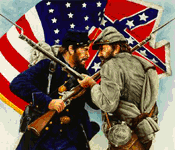 |
Civil War Battles |
|
State War Records |
| AL - AK - AZ - AR - CA - CO - CT - DE - FL - GA - HI - ID - IL - IN - IA - KS - KY - LA - MA - MD - ME - MI - MN - MS - MO - MT - NE - NV - NH - NJ - NM - NY - NC - ND - OH - OK - OR - PA - RI - SC - SD - TN - TX - UT - VT - VA - WA - WV - WI - WY |
The Battle of Kelly's Ford
March 17, 1863 in Kellysville, Virginia
 |
|||||||||||||||||||||
|
Early on the afternoon on February 25th, about 400 men of Brig. Gen. Fitzhugh Lee's cavalrymen surprised and routed Union cavalry outposts near Hartwood Church, capturing 150 Union troops belonging to Brig. Gen. William W. Averell's division. Lee and Averell were close friends, and lee jestly left a note behind, asking his old West Point classmate to retrurn the visit and bring some coffee.
While this Conmfederate attack embarrassed Averell, it infuriated Maj. Gen. Joseph Hooker, commander of the Union army. Hooker, who had recognized the Union cavalry into a corps, wanted these Confederate forays stopped and ordered his cavalry commander, Maj. Gen. George Stoneman, to end them or face relief from command. Within 3 weeks, Averell's scouts reported the presence of Lee's cavalry near Culpeper Court House, and the Union officer secured Stoneman's permission to return the visit.
Averell's division departed their lines on march 16th and long before sunrise on the 17th, the 2,100 men arrived opposite Kelly's Ford on the Rappahannock River. Forwarned, lee's pickets, behind felled trees, stubbornly prevented a crossing for 2 hours. Once on the south side, Averell advanced catiously, halting a mile from the ford, near 2 farms. Lee, meanwhile, with only 800 men, moved torward the Union force. The Confederates met them at noon and soon charged.
For the next 5 hours, the commands fought each other in a series of attacks and counterattacks. Mounted and dismounted, they battled across the farmlands and along stone walls. Averell, using his numerical advantage and an artillery battery, repulsed Lee's galloping thrusts, and the 2nd Virginia Cavalry, for the first time in the war, fled before a Union cavalry charge. Union artillery blasts erased entire squadrons of Virginians. In one Confederate assault near the Wheatley farmhouse, Maj. John pelham, the 25-year old commander of the cavalry's horse artillery, having come along as a spectator, was mortally wounded from a piece of shell to his skull. Major Pelham did not die instantly. Harry Gilmore took him from the field laying him over a horse, and proceeded to Elk Wood where he was laid out for water and attempted care. Unconscious and caked in dried blood, and a loss there-of he was transferred to an ambulance (the two wheeler ) and taken to the home of Miss Bessie Shackleford where nurse and caregivers received him. Four doctors attending conferred that the shrapnel had not penetrated the skull, but that the swelling of the brain brought on clotting and loss of any thought processes. The 9 mile trip and its complications was enough to do him in and Jeb Stuart leaning over him the early hours of March 18 at the Shackleford home stated "The gallant Pelham is no more"
Averell finally pushed the Confederates back a mile, but Lee again counterattacked. The Confederate cavalry crashed into the Federals in a classic cavalry attack. sabers and pistols emptied saddles, but the federals held. About 5:30 P.M., Averell withdrew.
for the first time in battle, Union cavalry had matched the superb Confederate cavalry blow for blow. After achieving a localized success, Union forces withdrew in mid-afternoon. Before Averell recrossed the river, he left Lee a sack of coffee and a note asking how his old comrade had enjoyed the visit.
Kelly's Ford was one of the early larger scale cavalry fights in Virginia that set the stage for Brandy Station and cavalry actions of the Gettysburg Campaign.
